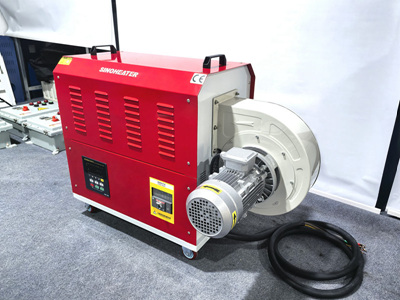Precision Thermal Control for Plastic Surface Deformation Using Hot Air Blowers
Plastic surface deformation requires controlled heating to achieve precise shaping without compromising material integrity. Hot air blowers provide a non-contact method for softening thermoplastics, enabling operations like edge rounding, embossing, and 3D contouring. This guide explores temperature thresholds, time management, and airflow optimization for common plastics such as polyethylene, polypropylene, and polycarbonate.
Temperature Thresholds for Controlled Plastic Softening
Thermoplastics exhibit distinct melting ranges and glass transition temperatures (Tg), which dictate the heating parameters for surface deformation. Overheating can lead to bubbling, discoloration, or structural collapse, while insufficient heat results in incomplete shaping.
Material-Specific Temperature Ranges:
- Polyethylene (PE): Softens at 80–100°C; ideal for edge rounding and embossing.
- Polypropylene (PP): Requires 120–140°C for surface deformation due to its higher Tg.
- Polycarbonate (PC): Needs 160–180°C for precise contouring without stress cracking.
- Acrylonitrile Butadiene Styrene (ABS): Best deformed at 100–120°C to maintain dimensional stability.
Heating Zone Configuration:
- Preheating Zone: Apply 60–70°C to gradually raise plastic temperature and reduce thermal shock.
- Active Deformation Zone: Maintain target temperature (e.g., 130°C for PP) within ±5°C accuracy.
- Cooling Zone: Use ambient airflow to stabilize the deformed shape at 40–50°C.
Defect Prevention:
- Localized Overheating: Use infrared sensors to monitor surface temperature and adjust hot air intensity.
- Uneven Softening: Rotate plastic parts during heating to ensure uniform thermal penetration.
- Residual Stress: Implement a gradual cooling ramp (5–8°C per minute) to minimize warping.
Advanced Techniques:
- Dual-Zone Heating: Combine hot air with infrared lamps for surface heating without overheating interiors.
- Pulse Heating: Apply intermittent hot air bursts (3 seconds on, 2 seconds off) to control softening depth.
Airflow Management for Precision Surface Shaping
Hot air blower performance hinges on airflow velocity, nozzle design, and distance from the plastic surface. Improper airflow can cause uneven deformation or material displacement.
Nozzle Selection:
- Conical Nozzles: Direct heat in a 15–30° angle for focused applications on edges or corners.
- Slot Nozzles: Distribute heat evenly across flat surfaces (e.g., 50×50 cm panels) with ±2°C accuracy.
- Deflector Nozzles: Create turbulent airflow to heat irregularly shaped parts uniformly.
Airflow Velocity and Distance:
- Low-Velocity (2–5 m/s): Ideal for thin plastics (≤2mm) to prevent surface distortion.
- Medium-Velocity (5–10 m/s): Suitable for medium-thickness plastics (2–5mm) for balanced heating.
- High-Velocity (10–15 m/s): Required for thick plastics (5–10mm) to ensure deep thermal penetration.
- Optimal Distance: Maintain 5–15 cm between nozzle and plastic surface to avoid excessive heat concentration.
Airflow Patterns:
- Linear Flow: Use for straight-edge deformation and uniform surface heating.
- Swirling Flow: Ideal for complex geometries to eliminate dead zones.
- Oscillating Flow: Apply for large-area heating to reduce processing time by 20–30%.
Defect Prevention:
- Airflow Stagnation: Install fans to circulate exhaust air and maintain consistent heating.
- Surface Blowing: Adjust nozzle angle to prevent hot air from displacing softened plastic.
- Dust Contamination: Filter intake air to avoid particulate deposition on heated surfaces.
Process Optimization for Defect-Free Plastic Deformation
Achieving flawless plastic surface deformation requires adherence to sequential protocols and real-time adjustments.
Step-by-Step Deformation Process:
- Surface Preparation: Clean plastic parts with isopropyl alcohol to remove oils and contaminants.
- Initial Heating: Apply hot air at 70% intensity for 1–2 minutes to soften the surface layer.
- Deformation Application: Use molds, rollers, or manual tools to shape the plastic while maintaining target temperature.
- Intermediate Heating: Reapply hot air for 30–60 seconds if deformation resistance increases.
- Final Cooling: Allow parts to cool naturally in a controlled environment (20–25°C) for 5–10 minutes.
Material-Specific Adjustments:
- Amorphous Plastics (PS, PMMA): Heat faster (10–15°C per minute) due to their lack of crystalline structure.
- Semi-Crystalline Plastics (PE, PP): Heat gradually (5–8°C per minute) to avoid sudden melting.
- Filled Plastics (GF-PP, CF-PA): Increase heating time by 15–20% to compensate for reduced thermal conductivity.
Defect Prevention Strategies:
- Surface Blistering: Limit heating time to 80% of the theoretical softening duration.
- Edge Cracking: Pre-heat edges for an additional 30 seconds before deformation.
- Dimensional Shrinkage: Post-cool parts under pressure (e.g., clamps) to maintain shape.
Advanced Techniques:
- Hot Air-Infrared Hybrid Heating: Combine hot air for bulk heating with infrared for surface finishing, reducing cycle time by 25%.
- Zone Control: Use multiple hot air blowers to create temperature gradients for multi-step deformation.
- Feedback Systems: Integrate pyrometers and PLCs to adjust airflow and temperature in real time.
By integrating these techniques, manufacturers can achieve precise plastic surface deformation with minimal defects. Continuous monitoring of temperature, airflow, and material response ensures optimal results across diverse plastic types and applications.




